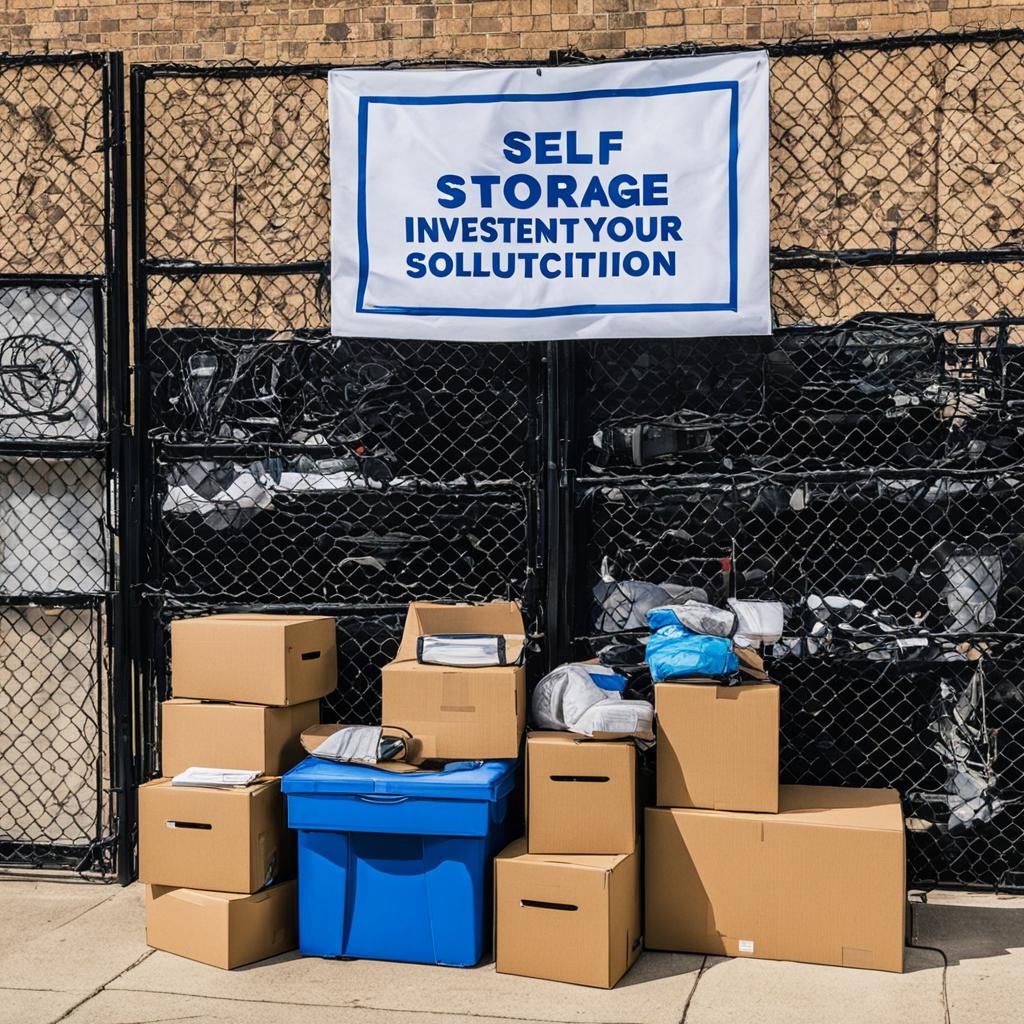Hello! Welcome to the Self Storage Investing Guide for Beginners. If you’re looking for a lucrative investment opportunity that offers portfolio diversification and a steady passive income source, self storage investing might be just what you need. Investing in self storage provides low risk, high demand, a stable income stream, economic durability, low maintenance, and a flexible business model. In this guide, I’ll walk you through all the necessary information you need to navigate the self storage investing market and make informed decisions.
But before we dive in, let’s take a moment to understand what self storage investment is all about.
Key Takeaways:
- Self storage investing offers portfolio diversification and a steady passive income source.
- Investing in self storage provides low risk, high demand, a stable income stream, economic durability, low maintenance, and a flexible business model.
- This guide will provide you with all the necessary information to navigate the self storage investing market.
Understanding Self Storage Investment
Self storage investment involves investing funds in self storage facilities and earning a return through rental income from storage units. Investors can choose to be an active investor by operating and managing the facility or a passive investor with no participation in business operations. The rental income is generated from individuals and small to medium-sized businesses who rent the storage units for short or long-term purposes.
| Active Investor | Passive Investor |
|---|---|
| An active investor takes an active role in the daily operations and management of the self storage facility. | A passive investor has no involvement in the operations or management of the self storage facility. |
| An active investor has the opportunity to have a hands-on approach, implementing strategies to optimize rental income and reduce expenses. | A passive investor can enjoy the benefits of rental income without the responsibilities of managing the facility. |
Investing in self storage facilities can provide a consistent rental income stream that is generated by individuals and businesses in need of extra space for their belongings. This makes self storage a popular investment option for both active and passive investors.
Reasons to Invest in Self Storage
Investing in self storage offers numerous benefits for individuals looking to enter the real estate market. With its combination of low risk, high demand, stable income stream, economic durability, low maintenance, and flexible business model, self storage investment provides a compelling opportunity for investors seeking a profitable venture.
Low Risk and Operating Costs
Self storage investment is considered a low-risk option due to its low operational costs and minimal business and operating risks. Compared to other real estate investments, self storage facilities have relatively low overhead expenses, including utilities, maintenance, and staffing. This allows investors to maximize their profits and generate a healthy return on investment.
High Demand and Stable Income Stream
One of the key advantages of investing in self storage is the consistently high demand for storage space. The need for self storage units arises from various factors such as downsizing, relocation, or business expansion. This high demand ensures high occupancy rates and a stable income stream for investors, providing a reliable source of passive income.
Economic Durability and Resilience
Self storage has demonstrated great resilience during economic downturns and recessions. It is an economically durable investment that remains relatively unaffected by market fluctuations. Even in challenging times, individuals and businesses continue to require storage solutions, making self storage a recession-resistant investment opportunity.
Low Maintenance and Flexibility
Maintaining a self storage facility is relatively low compared to other types of real estate investments. The facilities require minimal ongoing maintenance, primarily focusing on security systems, fire protection equipment, and basic infrastructure. Additionally, the flexible nature of the self storage business model allows investors to adapt to different economic conditions and adjust rental rates accordingly.
Overall, investing in self storage provides a low-risk opportunity with a high demand for storage space, a stable income stream, economic durability, low maintenance, and a flexible business model. This combination of factors makes self storage a lucrative investment option for individuals looking to diversify their portfolios and establish a reliable source of long-term passive income.
Low Risk in Self Storage Investment
When it comes to investing, minimizing risk is a top priority. Fortunately, self storage investment offers a low-risk opportunity for investors looking to diversify their portfolio and generate stable returns. Let’s explore why self storage investment is considered low risk.
Low Operational Costs
A major advantage of self storage investment is its low operational costs. Unlike other real estate investments that may require significant maintenance and ongoing expenses, self storage facilities have relatively low overhead costs. With minimal staff required and limited amenities to maintain, operational expenses can be kept to a minimum, allowing investors to maximize their profits.
High Profit Margins
Self storage investment also offers high profit margins, making it an attractive option for investors. The rental income generated from storage units provides a steady cash flow and contributes to the high profitability of this investment. With the ability to set rental rates and adjustable leasing terms, self storage investors can optimize their profit margins and maximize their returns.
Rental Income and Tenant Non-compliance
The rental income obtained from self storage units adds to the appeal of this investment. Tenants typically pay a monthly fee for the use of storage space, providing a consistent stream of income. Moreover, in case of tenant non-compliance or failure to pay rent, self storage facilities have the option to mark a lien against the tenant’s property, compensating for unpaid dues. This additional layer of protection helps mitigate the risk of potential financial losses.
Consistent Demand and Low Vacancy
Self storage investment benefits from a consistent demand for storage space, reducing the risk of vacancies. Whether it’s individuals needing temporary storage during a move or businesses requiring extra space for inventory and supplies, the demand for self storage units remains steady. This sustained demand ensures a continuous flow of tenants, minimizing the risk of prolonged vacancies and maximizing rental income.
Investing in self storage provides a low-risk opportunity to generate stable income and diversify your investment portfolio. With low operational costs, high profit margins, and consistent rental income, self storage investment offers a secure avenue for long-term financial growth.
High Demand for Self Storage
Self storage businesses experience a significant demand for storage space, making it a lucrative investment opportunity. From individuals looking to declutter their homes to small and large businesses in need of extra space, there is an ongoing need for self storage facilities. This high demand translates into excellent occupancy rates and a steady flow of rental income for investors.
But what sets self storage apart from other investment options is the potential for additional revenue through various add-ons. By offering attractive amenities such as loading and unloading equipment or vending machines, investors can attract more tenants and generate additional income. These add-ons not only increase the capacity of the facility but also provide convenience and value for tenants.
Take a look at some of the common add-ons that can enhance your self storage investment:
- Loading and unloading equipment: By providing dollies, carts, and other moving equipment, you can make it easier for tenants to transport their belongings to and from their storage units.
- Vending machines: Installing vending machines for packing supplies, snacks, or drinks can be a profitable addition to your facility. Tenants appreciate the convenience of having supplies available on-site.
- RV and boat storage: If your facility has space, consider offering storage options for recreational vehicles and boats. This can attract a niche market and provide additional rental income.
By diversifying your revenue streams with these add-ons, you can maximize the profitability of your self storage investment and cater to a broader range of customers.
The high demand for self storage facilities, coupled with the opportunity for additional income through add-ons, makes self storage investment an attractive choice for investors looking for a stable and profitable venture.
“The demand for self storage facilities continues to grow, providing investors with a reliable and steady source of rental income.”
– John Smith, Self Storage Investor
In the next section, we will explore the stable income stream that self storage investment can provide and how it differs from other real estate investments.
Stable Income Stream in Self Storage Investment
Investing in self storage offers a unique opportunity to generate a stable income stream. Unlike other real estate investments, self storage units consistently maintain high occupancy levels, ensuring a steady flow of rental income from tenants. The ongoing need for storage space creates a reliable and consistent demand for self storage units, making it a viable investment option for those seeking a stable income stream.
By capitalizing on the constant demand for storage space, self storage investors can benefit from a reliable rental income that remains relatively unaffected by market fluctuations. While other real estate sectors may experience fluctuations in occupancy rates that impact rental income, self storage units tend to provide a consistent and stable source of revenue. This stability is particularly appealing to investors looking for a reliable and predictable cash flow.
Whether individuals or businesses require short-term or long-term storage solutions, the need for storage space remains constant. This ongoing demand ensures that self storage units maintain high occupancy levels, resulting in a consistent rental income for self storage investors. The ability to generate stable income over time is a significant advantage of investing in self storage.
The reliability of rental income from self storage units is further reinforced by the fact that self storage facilities operate on a month-to-month leasing model. This allows for flexibility in adjusting rental rates to market conditions and maintaining competitive pricing to attract tenants. With diligent management and marketing efforts, self storage investors can maximize occupancy levels and optimize rental income.

Investing in self storage allows individuals to benefit from a stable income stream while diversifying their investment portfolio. Whether as a primary investment or as part of a broader real estate investment strategy, the steady rental income generated by self storage units offers financial security and the potential for long-term wealth accumulation.
In conclusion, self storage investment provides a unique opportunity to generate a stable income stream through consistently high occupancy levels and ongoing demand for storage space. By capitalizing on this demand, investors can secure a reliable and predictable source of rental income. As an attractive investment option, self storage offers stability, diversification, and the potential for long-term financial growth.
Economic Durability of Self Storage Investment
Investing in self storage offers not only the potential for substantial profits but also the proven economic durability that can weather challenging times. Throughout economic downturns such as the 2008 financial crisis and the recent Covid-19 pandemic, self storage investments have demonstrated their resilience and continued earning potential.
One of the key factors contributing to the economic durability of self storage investment is its low operating costs. Compared to other forms of real estate investment, self storage facilities require minimal maintenance and expenses, resulting in higher profit margins for investors.
Furthermore, self storage provides a reliable source of passive income. Once the storage units are set up and tenants are secured, rental income flows steadily month after month, providing investors with a stable and consistent cash flow.
In addition to low operating costs and passive income, self storage investments also offer portfolio diversification. With a well-balanced investment strategy, incorporating self storage alongside other asset classes can help mitigate risk and create a more resilient investment portfolio.
Overall, self storage investing provides an attractive opportunity for investors looking for economic durability, low operating costs, healthy profit margins, passive income, and portfolio diversification.
Benefits of Self Storage Investment:
- Economic durability even during challenging times
- Low operating costs leading to high profit margins
- Stable and passive income stream
- Portfolio diversification
Investing in self storage offers a secure and lucrative pathway to financial success. With its proven economic durability, low operating costs, and passive income, self storage investment is an ideal addition to any well-rounded investment portfolio.
| Key Features of Self Storage Investment | Benefits |
|---|---|
| Economic Durability | Resilient during economic downturns |
| Low Operating Costs | Higher profit margins |
| Passive Income | Steady cash flow |
| Portfolio Diversification | Risk mitigation |
Low Maintenance in Self Storage Investment
When it comes to self storage investment, one of the key advantages is the low maintenance required for managing a facility. Self storage facilities have simple and easy-to-maintain infrastructure, making it an attractive option for investors.
The main requirements for a self storage facility are a secure space with good lighting, a reliable security system, and proper fire protection equipment. These essential features ensure the safety and security of the stored belongings, giving tenants peace of mind.
By implementing a state-of-the-art security system, such as surveillance cameras, access control gates, and alarm systems, self storage facilities can provide a secure environment for tenants. This not only safeguards their belongings but also enhances the facility’s reputation and tenant retention.
In addition to security measures, the installation of fire protection equipment is crucial for the safety of both tenants and their stored items. Smoke detectors, fire alarms, and sprinkler systems help mitigate the risk of fire-related incidents, protecting the facility and its contents from potential damage.
Furthermore, with the advancements in technology, self storage management software has made operations much more efficient and streamlined. This automation includes profile management, billing and invoice management, storage unit booking, move-ins and move-outs, and managing overdue payments. By utilizing such software, investors can reduce the need for on-site staff, cutting down on operational costs and enabling a smooth running of their self storage facility.
By having a self storage facility with low maintenance requirements, investors can focus on the strategic aspects of their investment rather than spending excessive time and resources on facility management. This allows them to allocate their efforts towards expanding their portfolio, optimizing rental income, and ensuring customer satisfaction.
Investing in self storage offers a low-maintenance investment opportunity with a high potential for returns. With simple infrastructure requirements, a robust security system, and fire protection equipment in place, maintenance becomes hassle-free. The use of self storage management software further streamlines operations, reducing the need for on-site staff and optimizing efficiency. This low-maintenance aspect makes self storage investment an attractive option for investors seeking a passive income stream with minimal effort.
Flexible Business Model in Self Storage Investment
The self storage business model offers flexibility to adapt to different economic situations. As an investor, I can start with an empty building and gradually scale up operations as profits increase. This allows me to tailor my investments according to market demands and financial feasibility.
One way to enhance the self storage business model is by offering self-service kiosks. These automated systems provide convenience to customers, allowing them to rent or access storage units without staff assistance. This not only reduces operational costs but also improves customer satisfaction.
Another option for diversifying the business model is by implementing valet storage services. Valet storage involves picking up and delivering items to and from customers’ locations, providing them with a convenient storage solution. This service adds value and attracts customers who may require assistance with transporting their belongings.
To efficiently manage a self storage facility, leveraging management software is essential. This software streamlines operations by automating tasks such as inventory management, billing, and customer profiles. With the help of management software, I can ensure seamless operations and optimize the use of resources.
The flexibility of the self storage business model also allows me to adapt my investment strategy based on market conditions. During economic booms, I can focus on acquiring storage units for sale, capitalizing on the increased demand. On the other hand, during recessions or economic downturns, the demand for rental units may rise as individuals and businesses downsize or seek temporary storage solutions.
Benefits of a Flexible Business Model:
- Adaptability to market conditions
- Cost-effective operations through self-service kiosks
- Additional revenue streams through valet storage services
- Efficient management with the help of software solutions
- Strategic investment decisions based on economic cycles
“The flexibility of the self storage business model allows me to cater to varying customer needs and market demands, ensuring long-term profitability and success in the industry.”
With a flexible business model, self storage investment offers numerous opportunities for innovation and growth. By embracing self-service technologies, exploring valet storage services, utilizing management software, and adapting to changing market conditions, investors can maximize their success in the self storage industry.
Risks in Self Storage Investment
Investing in self storage comes with its fair share of risks that every investor should be aware of. Let’s take a closer look at some key risks associated with self storage investment:
Market Positioning
Market positioning is a crucial factor in the success of a self storage investment. It involves thoroughly analyzing competitors, understanding customer demands, and offering the right amenities. Failure to position your storage facility effectively can result in lower occupancy rates and decreased profitability.
Active Management
Active management is essential for the smooth operation and upkeep of a self storage facility. It requires continuous monitoring of security systems, maintenance, and overall business operations. Neglecting active management can lead to tenant dissatisfaction, increased vacancy rates, and potential loss of revenue.
Oversupply
The self storage market is not immune to oversupply, which can pose challenges for investors. An oversaturated market can increase competition among storage facilities, resulting in decreased demand and lower rental rates. Investors need to carefully assess market dynamics and ensure a balanced supply-demand ratio before making an investment.
Storage Facility Classes
Self storage facilities are classified into different categories: class A, class B, and class C. Each class has distinct characteristics and amenities that can influence the investment’s profitability. It’s crucial to understand the market demand for each class and assess the potential returns based on location, amenities, and rental rates.

Market Positioning in Self Storage Investment
When it comes to self storage investment, market positioning plays a crucial role in determining success. In order to stand out from the competition and attract tenants, it’s essential to carefully analyze the market, understand customer demands, and strategically position your self storage facility. Here’s how you can achieve effective market positioning:
Identify Competitors
A thorough assessment of your competitors is vital to determine the unique selling points of your self storage facility. Research other self storage businesses in your target location and identify their strengths and weaknesses. This will help you differentiate yourself and create a competitive advantage.
Understand Customer Demands
Knowing what potential tenants are looking for in a self storage facility is key to meeting their needs and attracting their business. Conduct market research and interact with customers to gain insights into their preferences. Consider factors such as unit sizes, climate control options, accessibility features, security measures, and convenient payment methods.
Build the Right Mix of Storage Units
Offering a diverse range of storage units is essential to cater to a wide variety of customer needs. This includes different sizes, climate-controlled options, and specialized units for items like vehicles or business inventory. By providing a comprehensive selection, you can attract a broader customer base and increase your occupancy rates.
Offer Desirable Amenities
Enhancing your self storage facility with amenities can significantly improve its market positioning. Consider amenities like 24/7 access, state-of-the-art security systems, on-site management, package acceptance services, and even ancillary services like truck rentals or moving supplies. These added features can differentiate your facility and attract customers seeking convenience and peace of mind.
Secure an Ideal Real Estate Space
The location of your self storage facility has a significant impact on its market positioning. Look for a space that is easily accessible, visible, and situated in a prime area with high residential or commercial activity. A strategically chosen location can make your facility more appealing to potential tenants and increase your chances of success.
Remember, effective market positioning is a combination of thorough analysis, understanding customer demands, and executing a well-defined strategy. By designing a compelling offering that meets the needs of your target market, you can establish a strong presence in the self storage industry and maximize your returns.
| Competitor Analysis | Customer Demands | Storage Unit Variety | Amenities | Real Estate Space |
|---|---|---|---|---|
| Identify strengths and weaknesses of competitors | Research customer preferences and needs | Create a diverse range of storage units | Enhance facility with desirable amenities | Secure a prime location with high visibility |
| Develop a competitive advantage | Meet customer demands effectively | Attract a broader customer base | Differentiate facility from competitors | Increase chances of success |
Active Management in Self Storage Investment
Contrary to common assumptions, self storage management requires active involvement. While automation through management software can streamline operations, active management is still required to oversee security systems, maintenance, and overall business operations. A comprehensive business plan and expert team are essential for successful self storage investment.
When it comes to self storage investment, active management is key. It’s not enough to simply set up your storage facility and let it run on its own. You need to be actively involved in overseeing the day-to-day operations to ensure everything is running smoothly and efficiently.
Active management includes:
- Monitoring security systems
- Maintaining the facility
- Managing rental agreements and payments
- Handling customer inquiries and concerns
- Implementing marketing strategies to attract tenants
By actively managing your self storage investment, you can ensure the security of your facility and the satisfaction of your tenants. Regularly reviewing and updating your security systems can help prevent theft or damage to stored items, providing peace of mind to your customers.
“Active management is essential to address issues promptly and maintain a positive customer experience. It allows us to provide the highest level of service and ensure the long-term success of our self storage investment.”
In addition to security, regular maintenance is crucial to keep your facility in top condition. This includes routine inspections, repairs, and cleanliness to create a safe and appealing environment for tenants. A well-maintained facility enhances customer satisfaction and helps attract new tenants through positive word-of-mouth.
A comprehensive business plan serves as your roadmap for success in self storage investing. It outlines your goals, strategies, and financial projections, allowing you to track your progress and make informed decisions. Furthermore, having an expert team by your side can offer valuable insights and support in navigating the complexities of the self storage industry.
Remember:
- Active management ensures smooth operations and tenant satisfaction
- Regularly monitor security systems and implement necessary updates
- Maintain the facility to create a safe and appealing environment
- Develop a comprehensive business plan to guide your investment
- Seek guidance from an expert team in the self storage industry
By actively managing your self storage investment, you can maximize its potential and reap the rewards of a successful venture.

Risk of Oversupply in Self Storage Investment
The increasing popularity of self storage investment has brought about a potential risk of oversupply in the market. As more investors recognize the lucrative opportunities in self storage, there is a growing number of self storage facilities being developed. While this signifies a thriving industry, it also poses challenges such as intensified competition and potential oversaturation of the market.
When an oversupply occurs, the demand for a particular self storage facility may decrease, resulting in reduced occupancy rates and rental income. This can create a competitive landscape where facilities struggle to attract tenants and may need to lower rental rates to remain competitive.
To mitigate the risk of oversupply, investors should conduct thorough market research and analysis. Understanding the demand and supply dynamics of the local market is crucial. Assessing demographic factors, population growth, and existing competition can provide valuable insights into the demand for self storage facilities in a particular area.
Additionally, investors should consider the potential growth of the market and evaluate whether the supply of self storage facilities is in line with the projected demand. A careful assessment of the current market conditions and future growth prospects can help investors make informed decisions and avoid potential pitfalls.
By ensuring there is a sufficient demand-supply balance, investors can position themselves strategically in the market and increase the likelihood of a successful self storage investment. A thoughtful approach that takes into account market conditions and competition can help investors capitalize on the opportunities while mitigating the risks associated with oversupply.
It is essential to stay proactive and continually monitor the market to adapt to changing conditions. Regular assessments of market demand and competition allow investors to make necessary adjustments to their strategies to remain competitive and attract tenants.
Classes of Self Storage Facilities
When considering self storage investment, it’s crucial to understand the different classes of self storage facilities. These classes, namely class A, class B, and class C, vary in terms of amenities, rental charges, and location. Let’s explore each class in detail:
Class A Facilities
Class A facilities are the newest and most sought-after in the market. They boast modern amenities, state-of-the-art security features, and convenient locations. Due to their desirable attributes, class A facilities command higher rental charges compared to other classes.
Class B Facilities
Class B facilities are older than class A, but still well-maintained and reliable. While they may lack some of the modern amenities found in class A facilities, they offer reasonable amenities such as climate control, 24/7 access, and adequate security. Class B facilities typically have lower rental charges than class A facilities, making them attractive options for cost-conscious investors.
Class C Facilities
Class C facilities are the oldest among the three classes. They may lack some of the amenities found in class A and class B facilities and are located in less desirable areas. However, they still serve a purpose for individuals and businesses seeking affordable storage options. Class C facilities generally have the lowest rental charges, making them suitable for budget-minded investors.
When making an investment decision in the self storage market, it’s essential to evaluate the features and amenities offered by each class, as well as the rental charges and location. Understanding the distinctions between the classes can help investors align their investment goals with the right type of facility.
By catering to the diverse storage needs and preferences of individuals and businesses, self storage investment offers a promising opportunity for long-term success.
Ways to Invest in Self Storage
When it comes to self storage investing, there are several popular ways to get involved and capitalize on this thriving market. Here are some options for investors looking to make their mark in the self storage industry:
- Invest in Real Estate Investment Trusts (REITs): REITs are investment vehicles that own and manage portfolios of self storage facilities. By investing in REITs, you can gain exposure to the self storage market without the need to directly manage properties. It offers the potential for passive income and diversification within the real estate sector.
- Buy and Operate Existing Self Storage Facilities: Another approach is to buy an existing self storage facility and take on the role of an owner-operator. This option allows you to have full control over the operations, management, and profitability of the facility. It requires a hands-on approach, suitable for those looking for an active role in their self storage investment.
- Build Your Own Self Storage Facility: For those with a more entrepreneurial spirit, building your own self storage facility from the ground up is an exciting option. This approach involves acquiring land, obtaining necessary permits, constructing the facility, and attracting tenants. It requires substantial upfront investment and extensive knowledge of the industry.
- Invest in a Self Storage Syndicate: A self storage syndicate is a group of investors that pool their funds together to invest in self storage properties. This collaborative approach allows investors to share the risks and rewards of the investment. It is a viable option for those seeking to leverage their capital by joining forces with other like-minded individuals.
Each investment option has its own merits and considerations, and it’s important to carefully evaluate your financial goals, risk tolerance, and level of involvement before making a decision.

Comparison of Investment Options:
| Investment Option | Advantages | Considerations |
|---|---|---|
| REITs | – Passive income and diversification – Professional management – Access to a diverse portfolio |
– Dependency on market performance – Limited control over specific properties |
| Buy and Operate Facilities | – Full control and ownership – Hands-on management – Profitability potential |
– Requires active involvement – Operational responsibilities – Market competition |
| Build Your Own Facility | – Customization and control – Long-term asset value – Scalability |
– Higher upfront costs – Construction process and timelines – Market feasibility |
| Self Storage Syndicate | – Pooling capital and risks – Collective expertise – Investment diversification |
– Aligning interests with co-investors – Decision-making dynamics – Syndicate management |
Conclusion
Investing in self storage can be a lucrative opportunity for investors, providing diversification and a passive source of income. With its high demand, stable income stream, and low maintenance requirements, self storage investment presents an attractive option for those seeking potential returns.
By carefully understanding and evaluating the risks and market dynamics associated with self storage investing, investors can make informed decisions and maximize their chances of success. The low operational costs, high-profit margins, and consistent rental income from storage units contribute to the overall appeal of this investment.
Furthermore, self storage investment offers the potential for portfolio diversification, allowing investors to spread their resources across different asset classes. This diversification can help mitigate risks and enhance overall investment performance.
Overall, self storage investment provides an opportunity to generate passive income while benefiting from the growing demand for storage space. By leveraging a solid understanding of the market, investors can position themselves for long-term success and maximize their potential returns in the self storage industry.
FAQ
What is self storage investment?
Self storage investment involves investing funds in self storage facilities and earning a return through rental income from storage units.
What are the benefits of investing in self storage?
Investing in self storage offers benefits such as low operational costs, high demand, stable income stream, economic durability, low maintenance, and a flexible business model.
Is self storage investment considered low risk?
Yes, self storage investment is considered low risk due to its low operational costs, high profit margins, steady rental income, and the ability to mark a lien against delinquent tenants’ property.
Why is there high demand for self storage?
There is high demand for self storage due to the need for storage space by individuals, small businesses, and large businesses.
Can self storage provide a stable income stream?
Yes, self storage units have consistently high occupancy rates, ensuring a steady flow of rental income.
Is self storage economically durable?
Yes, self storage has shown resilience during economic downturns and is considered economically durable due to its low operating costs and decent profit margins.
How low is the maintenance for self storage facilities?
Self storage facilities have relatively low maintenance requirements, mainly consisting of maintaining a secure space, good lighting, a security system, and fire protection equipment.
Can self storage investment adapt to different economic situations?
Yes, the self storage business model offers flexibility, allowing investors to adjust to different economic situations, such as acquiring storage units for sale during economic booms or meeting the increased demand for rental units during recessions.
What are the risks associated with self storage investment?
Risks in self storage investment include market positioning challenges, the need for active management, the risk of oversupply in the market, and differentiating between different classes of self storage facilities.
How important is market positioning in self storage investment?
Market positioning is crucial for success in self storage investment as it involves identifying competitors, understanding customer demands, offering desirable amenities, and securing an ideal real estate space in a prime location.
Is active management required for self storage investment?
Yes, active management is necessary for self storage investment to ensure the smooth running and upkeep of the facility, including overseeing security systems, maintenance, and overall business operations.
What is the risk of oversupply in the self storage market?
The risk of oversupply in the self storage market can lead to intensified competition and reduced demand for a particular facility, highlighting the importance of careful market analysis before investing in a self storage facility.
What are the different classes of self storage facilities?
Self storage facilities are classified into class A, class B, and class C, each with different amenities, rental charges, and locations.
How can I invest in self storage?
Investors can choose to invest in self storage through real estate investment trusts (REITs), buying and operating an existing facility, building their own facility, or investing in a self storage syndicate by pooling funds with other investors.
What is the potential return on self storage investment?
Self storage investment can be a profitable venture, offering diversification and a passive source of income with the potential for high demand, stable income stream, and low maintenance.
Our Friends
- https://millennialmoney.com/self-storage-investing/
- https://storeganise.com/blog/how-to-invest-in-self-storage
- https://selfstorageinvesting.com/self-storage-investment-basics-the-beginners-guide/
Money posts:
 Neighbor Storage Review
Neighbor Storage Review
 Neighbor Review | A Legit & Easy Way to Make Passive Income in 2024
Neighbor Review | A Legit & Easy Way to Make Passive Income in 2024
 How to Invest in Rental Properties: A 4-Step Guide
How to Invest in Rental Properties: A 4-Step Guide
 Rooftop Review | Invest in Single Family Rental
Rooftop Review | Invest in Single Family Rental
 How to Invest $1 Million Dollars: Strategies and Tips for Growth and Security
How to Invest $1 Million Dollars: Strategies and Tips for Growth and Security
 Investing in Rental Property for Beginners: A Comprehensive Guide
Investing in Rental Property for Beginners: A Comprehensive Guide
 How to Buy an Investment Property
How to Buy an Investment Property
 Should You Be Investing in Commercial Real Estate Right Now? (2024 Guide)
Should You Be Investing in Commercial Real Estate Right Now? (2024 Guide)

